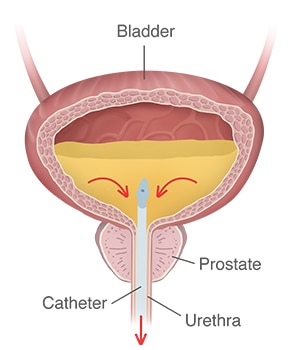Treatment of Urinary Retention
How do health care professionals treat urinary retention?
Health care professionals treat urinary retention based on the type of urinary retention—acute or chronic—and the cause of the urinary retention.
Draining the bladder
With acute urinary retention, a health care professional will immediately drain the urine from your bladder using a catheter. Removing the urine from the bladder eases your pain and helps prevent your bladder and kidneys from being damaged.
If you have chronic urinary retention, your health care professional will first try to diagnose and treat the cause of your retention. However, your health care professional may need to use a catheter to drain the urine from your bladder if the retention continues or becomes severe.
In some cases, people with urinary retention need to continue using a catheter to drain urine from the bladder until their urinary retention can be fixed. The catheter can be indwelling—left in your bladder for a short or long time, or intermittent—inserted to drain the bladder when needed and then removed. If you have to use an intermittent catheter, a health care professional can teach you how to use the catheter.

Medicines
Your health care professional may suggest that you take medicine to help treat the medical condition causing your urinary retention
- 5-alpha reductase inhibitors help to stop the growth of or shrink the prostate, which can improve the flow of urine. Examples include dutasteride and finasteride.
- Alpha-blockers treat the symptoms of prostate enlargement (benign prostatic hyperplasia) by relaxing muscles in the bladder neck and prostate, which makes it easier to urinate. Examples include alfuzosin, doxazosin, prazosin, silodosin, tadalafil, tamsulosin, and terazosin.
- A combination of a 5-alpha-reductase inhibitor and an alpha-blocker, such as finasteride and doxazosin or dutasteride and tamsulosin, may work better than an individual medicine alone.
- Antibiotics treat infections that may cause urinary retention, such as urinary tract infections and prostatitis.
In some people, certain medicines may cause urinary retention. If your health care professional thinks that a medicine is causing your urinary retention, you may be asked to lower the dose or stop using the medicine.
All medicines, even over-the-counter medicines, have side effects. Always consult a health care professional before using any medicine for more than a few days.
Medical procedures and devices
Your health care professional may recommend a medical procedure or device to treat your urinary retention, depending on the cause of the retention. Examples of these procedures and devices include
- cystoscopy—using a cystoscope to look inside the urethra and bladder to find and remove blockages such as urinary tract stones
- laser therapy—therapy that uses a strong beam of light to treat an area of enlarged prostate tissue by breaking up the blockage and reducing the obstruction
- prostatic urethral lift, or UroLift—using tiny implants to lift and hold the prostate away from the urethra so urine can flow more freely
- transurethral electrovaporization—a procedure that uses heat to vaporize an area of enlarged prostate tissue
- transurethral water vapor therapy, or Rezum—therapy that uses water vapor, or steam, to shrink an enlarged prostate
- urethral dilation—gradually increasing the size of the urethral opening by stretching the scar tissue, to help treat urethral stricture
- vaginal pessary—a stiff ring that is inserted into the vagina to help stop urine leakage, such as with cases of a cystocele (prolapsed bladder) or rectocele
Surgery
Your health care professional may consider surgery to help treat the cause of your urinary retention if other less invasive treatments don’t work. Some of these treatments may include
- removing part of the prostate
- repairing urethral strictures or bladder neck scar tissue
- repairing pelvic organ prolapse
- removing a tumor, abnormal uterus, or damaged portion of a herniated disc
- repairing an abnormal bladder
- performing a urinary diversion procedure to reroute the normal flow of urine out of your body
How can I treat my urinary retention?
Your health care professional may recommend you try self-care treatments—either alone or in addition to other treatments—to manage your urinary retention.
Do physical therapy
Your health care professional may suggest that you work with a physical therapist who specializes in pelvic floor problems. The physical therapist will work to stretch tight pelvic floor muscles and help you keep them relaxed. Pelvic floor muscle exercises, also called Kegel exercises, help the nerves and muscles that you use to empty your bladder work better.

Train your bladder
Your health care professional may suggest timed voiding—urinating at set times—to help prevent your bladder from becoming too full. Another bladder training technique that your health care professional may recommend is double voiding—waiting a short time after you urinate to try and go again—to help make sure your bladder is completely empty after you urinate.
Take extra time in the bathroom to relax and empty the bladder completely. Women should try to relax the muscles around their bladder when they urinate to make it easier to go. It’s best to sit on the toilet seat or in a full crouching squat. Hovering over a toilet seat to avoid touching it does not allow muscles to fully relax and may result in urine being left in the bladder.
This content is provided as a service of the National Institute of Diabetes and Digestive and Kidney Diseases
(NIDDK), part of the National Institutes of Health. NIDDK translates and disseminates research findings to increase knowledge and understanding about health and disease among patients, health professionals, and the public. Content produced by NIDDK is carefully reviewed by NIDDK scientists and other experts.

